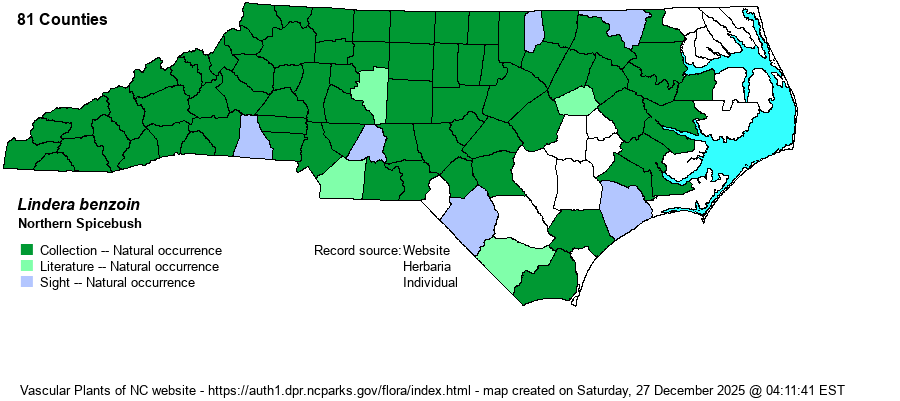| Author | (L.) Blume | |
| Distribution | Throughout the Mountains, Piedmont, and much of the Coastal Plain. Absent from many far eastern counties, and possibly a few south-central counties, in the Coastal Plain. Very rare in the Sandhills proper.
Widespread over the eastern US and extreme southern Ontario. Ranges south to the FL Panhandle and central TX.
| |
| Abundance | Common to very common in the Mountains, Piedmont, and brownwater river floodplains in the Coastal Plain, such as the Roanoke River floodplain. Uncommon and somewhat local over most of the rest of the Coastal Plain, nearly absent from the Sandhills proper. Can often be the dominant shrub species in some rich floodplains and very rich/mafic slopes. | |
| Habitat | This is a species of rich, circumneutral to slightly acidic soils of bottomland forests, Basic Mesic Forests, Rich Cove Forests, and the cooler and richer portions of Mesic Mixed Hardwood Forests. It may occur in swamps, though mostly in slightly higher elevations and in brownwater conditions. |
| Phenology | Blooms in March and April, before the leaves emerge; fruits in August and September. | |
| Identification | This is a medium-sized to fairly large, widely spreading deciduous shrub, reaching 12-15 feet tall. Broken twigs give off a lemon fragrance. The moderately large leaves are alternate, elliptic to more often obovate, and entire on the margins, averaging about 4 inches long and with a distinct "drip-tip" (contra L. subcoriacea). The bare branches are adorned with numerous clusters of small yellow flowers in early spring, before the leaves emerge; thus, one can spot this species at some distance in a forest in March and early April. By mid to late summer, the bright red berries are quite conspicuous. As this species is so common in much of the state, it seldom offers identification issues. If in doubt, break a twig and note the lemony fragrance. In the Sandhills and adjacent counties, L. subcoriacea can be found in acidic streamheads; its leaves are narrower and lack a drip-tip. See that species for identification features. | |
| Taxonomic Comments | Generally none, but L. subcoriacea was originally subsumed or un-recognized within L. benzoin.
| |
| Other Common Name(s) | Often called just “Spicebush”, but as there are several other Lindera species in the region, one or two also with this word in the name, the use of a modifier is best. Most sites use “Northern” as the modifier, but Common Spicebush is also in use. | |
| State Rank | S5 | |
| Global Rank | G5 | |
| State Status | | |
| US Status | | |
| USACE-agcp | FACW link |
| USACE-emp | FAC link |

